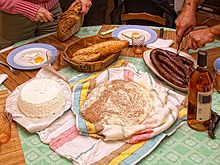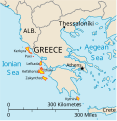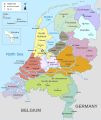Portal:Islands
The Islands Portal
An island or isle is a piece of subcontinental land completely surrounded by water. Very small islands such as emergent land features on atolls can be called islets, skerries, cays or keys. An island in a river or a lake island may be called an eyot or ait, and a small island off the coast may be called a holm. Sedimentary islands in the Ganges Delta are called chars. A grouping of geographically or geologically related islands, such as the Philippines, is referred to as an archipelago.
There are two main types of islands in the sea: continental islands and oceanic islands. There are also artificial islands (man-made islands).
There are about 900,000 official islands in the world. This number consists of all the officially-reported islands of each country. The total number of islands in the world is unknown. There may be hundreds of thousands of tiny islands that are unknown and uncounted. The number of sea islands in the world is estimated to be more than 200,000. The total area of the world's sea islands is approx. 9,963,000 sq km, which is similar to the area of Canada and accounts for roughly 1/15 (or 6.7%) of the total land area of Earth. (Full article...)
Selected article –
Ford Island (Hawaiian: Poka ʻAilana) is an islet in the center of Pearl Harbor, Oahu, in the U.S. state of Hawaii. It has been known as Rabbit Island, Marín's Island, and Little Goats Island, and its native Hawaiian name is Mokuʻumeʻume. The island had an area of 334 acres (135 ha) when it was surveyed in 1825, which was increased during the 1930s to 441 acres (178 ha) with fill dredged out of Pearl Harbor by the United States Navy to accommodate battleships.
It was the site of an ancient Hawaiian fertility ritual, which was stopped by Christian missionaries during the 1830s. The island was given by Kamehameha I to Spanish deserter Francisco de Paula Marín, and later returned to the monarchy. After the island was bought at auction by James Isaac Dowsett and sold to Caroline Jackson, it became the property of Dr. Seth Porter Ford by marriage and was renamed Ford Island. After Ford's death, his son sold the island to the John Papa ʻĪʻī estate and it was converted into a sugarcane plantation. (Full article...)
Selected cuisines, dishes and foods –

Related articles
- List articles
- List of islands
- List of islands by area
- List of islands by highest point
- List of islands by name
- List of islands by population
- List of islands by population density
- List of archipelagos
- List of archipelagos by number of islands
- List of artificial islands
- List of divided islands
- List of fictional islands
- List of island countries
- List of islands in lakes
- List of islands named after people
- List of islands of the European Union
- List of private islands
Selected image –
Did you know –

- ... that Pan Am executive Bill Mullahey was nicknamed "Mr. Pacific" for his work promoting tourism to Hawaiʻi and other island destinations?
- ... that the coat of arms of Jersey was allowed to be featured on its stamps during the occupation in World War II, with the Germans unaware that it was also the royal arms of England?
- ... that Micronations: The Lonely Planet Guide to Home-Made Nations features the Gay and Lesbian Kingdom of the Coral Sea Islands, the Kingdom of Lovely, and the Grand Duchy of Westarctica?
- ... that New Zealand's Native Island hosted a colony of Samoyeds and huskies used in both the Southern Cross and Nimrod expeditions to the South Pole?
- ... that Saunders Island has a lava lake and is populated by penguins?
- ... that 17 State Street, near the southern end of New York City's Manhattan Island, was described as "quite literally a beacon for Lower Manhattan"?
General images –
Related portals
WikiProjects
Topics
Categories
Associated Wikimedia
The following Wikimedia Foundation sister projects provide more on this subject:
-
Commons
Free media repository -
Wikibooks
Free textbooks and manuals -
Wikidata
Free knowledge base -
Wikinews
Free-content news -
Wikiquote
Collection of quotations -
Wikisource
Free-content library -
Wikiversity
Free learning tools -
Wikivoyage
Free travel guide -
Wiktionary
Dictionary and thesaurus
Things to do
 |
Here are some tasks awaiting attention:
|
Web resources
- Listing of islands from the United Nations Island Directory




















































![Image 51The Shamanka Шаманка [ru], a holy rock in Shamanism and one of the 9 most holy places in Asia, on the westcoast of Olkhon (from List of islands of Russia)](http://upload.wikimedia.org/wikipedia/commons/thumb/2/27/Shaman_Kamen.jpg/120px-Shaman_Kamen.jpg)
















































